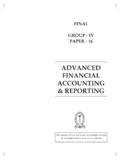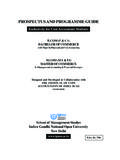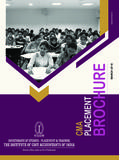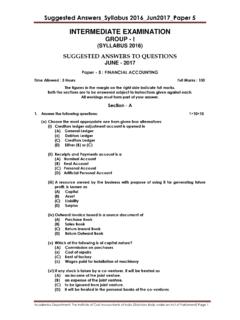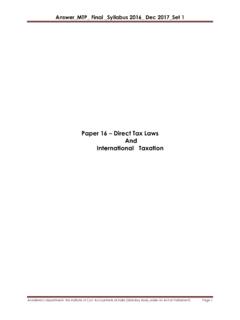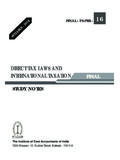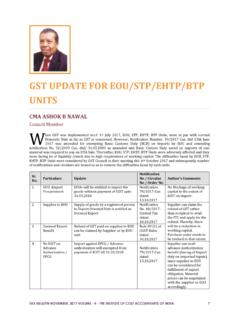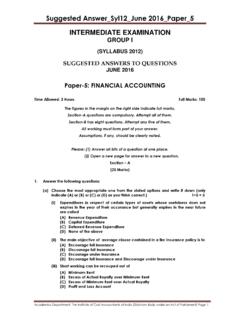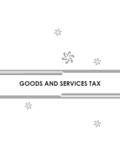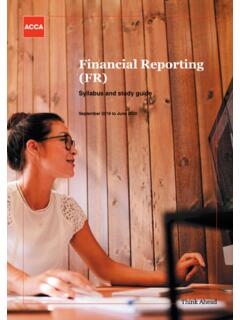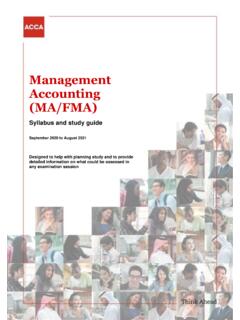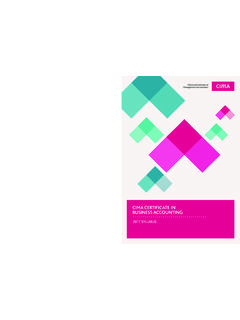Transcription of COST ACCOUNTING AND FINANCIAL MANAGEMENT …
1 INTERMEDIATE : PAPER - 8. COST ACCOUNTING . AND FINANCIAL . MANAGEMENT INTERMEDIATE. STUDY NOTES. The Institute of Cost Accountants of India CMA Bhawan, 12, Sudder Street, Kolkata - 700 016. First Edition : February 2013. Reprint of First Edition : October 2014. Second Edition : January 2016. Published by : Directorate of Studies The Institute of Cost Accountants of India (ICAI). CMA Bhawan, 12, Sudder Street, Kolkata - 700 016. Printed at : Repro India Limited Plot No. 02, MIDC Industrial Area, Mahape, Navi Mumbai 400 709, India. Website : Copyright of these Study Notes is reserved by the Insitute of Cost Accountants of India and prior permission from the Institute is necessary for reproduction of the whole or any part thereof. syllabus PAPER 8: COST ACCOUNTING AND FINANCIAL MANAGEMENT (CAFM). syllabus Structure: The syllabus comprises the following topics and study weightage: A Cost ACCOUNTING Prime Costs and Overheads 60%.
2 B FINANCIAL MANAGEMENT 40%. B. 40%. A. 60%. ASSESSMENT STRATEGY. There will be written examination paper of three hours OBJECTIVES. To provide an in depth study of the Generally Accepted Cost ACCOUNTING Principles and Techniques for identification, analysis and classification of cost components to facilitate managerial decision making. To understand the concepts of FINANCIAL MANAGEMENT and its application for managerial decision making. Learning aims The syllabus aims to test the student's ability to: U nderstand and explain the conceptual framework of Cost & MANAGEMENT ACCOUNTING E xplain the basic concepts and processes in determination of products and services cost I . dentify and apply the concepts of FINANCIAL MANAGEMENT Skill set required Level B: Requiring the skill levels of knowledge, comprehension, application and analysis. Section A : Cost ACCOUNTING Prime Costs & Overheads 60%.
3 1. General Purpose Cost Statement 2. Business Process Analysis Cost Centre and Cost Allocation (a) Materials (CAS 6). (b) Employee Costs (CAS 7). Direct expenses and problems connected therewith (CAS 10). (c) . Overhead (with reference to all Cost ACCOUNTING Standards related to Overhead). (d) . Section B : FINANCIAL MANAGEMENT 40%. 3. Overview of FINANCIAL MANAGEMENT 4. Tools for FINANCIAL Analysis & Planning 5. Working Capital MANAGEMENT and Leverage Analysis 6. Cost of Capital, Capital Structure Theories and Dividend Decisions 7. Capital Budgeting SECTION A: COST ACCOUNTING PRIME COSTS & OVERHEADS [60 MARKS]. 1. General Purpose Cost Statement: Cost ACCOUNTING Standards (CASs) (issued by the Institute of Cost Accountants of India from time to time), Generally Accepted Cost ACCOUNTING Principles (GACAP) Purpose, Objective and Applicability 2. Business Process Analysis Cost Centre and Cost Allocation (a) Materials (CAS 6): (i) Procurement of materials classification and coding, inventory MANAGEMENT and control, JIT (just in time), return to suppliers, pricing of receipts, Physical verification and related issues (ii) Scrap, wastage, pilferage, obsolescence, normal loss, abnormal loss (CASs related to above items) framework (b) Employee Costs (CAS 7): (i) Employee routines, classification of Employee, time keeping, time booking, payroll preparation, disbursement of wages.
4 Principles and methods of remuneration, Productivity Linked Incentive (PLI) Schemes (ii) ACCOUNTING control and reporting, ACCOUNTING for Employee Cost, Computation of Employee Cost rates, Idle time, Overtime, Employee turnover, Employee cost reporting (c) Direct expenses and problems connected therewith (CAS 10). (d) Overhead (with reference to all Cost ACCOUNTING Standards related to Overhead): (i) Classification of overheads; Overhead Cost ACCOUNTING (ii) ACCOUNTING and control of overheads, computation of pre-determined overhead recovery rates, treatment of over and under absorption of overhead costs. Reports of control of overhead costs (iii) Miscellaneous items of expenses capacity costs, treatment of depreciation in costs Note : All related further pronouncements of CASs will also be applicable SECTION B : FINANCIAL MANAGEMENT [40 MARKS]. 3. Overview of FINANCIAL MANAGEMENT (a) FINANCIAL MANAGEMENT meaning, objectives, scope, related finance disciplines, planning environment, key-decision areas (b) Sources of Finance ( Shares, Debentures, Debt, Public Deposits, Lease Financing, etc.)
5 ; criteria for selecting sources of finance including finance for International Investments and Venture Capital Funds (c) Other FINANCIAL services Hire Purchase, Forfeiting, Bill Discounting, Factoring, Asset Securitization (d) FINANCIAL Decision Making Emerging role of finance managers (e) Compliance of regulatory requirements in formulation of FINANCIAL strategies (f) Role of Treasury Function in terms of setting Corporate objectives, Funds MANAGEMENT -National and International (g) Contemporary developments WTO, GATT, Corporate Governance, TRIPS, TRIMS, SEBI Regulations (as amended from time to time). (h) Concepts of Value and Return Time preference for money, Future Value, Present Value, Net Present Value (NPV). 4. Tools for FINANCIAL Analysis & Planning (a) Funds flow and Cash flow Analysis (b) Analysis FINANCIAL Ratio and Cash Flow Ratios Ratios in the areas of performance, profitability, FINANCIAL adaptability, liquidity, activity, shareholder investment and financing, interpretation of ratios and limitations of ratio analysis (c) Identification of information required to assess FINANCIAL performance, Effect of short - term debt on the measurement of gearing 5.
6 Working Capital MANAGEMENT and Leverage Analysis (a) Working Capital policies related to Inventory, Receivables, Payables, Cash and Marketable securities (b) Financing of working capital (c) Concepts and nature of Leverages, Analysis of Operating and FINANCIAL Leverages, Operating Risk and FINANCIAL Risk and Combined Leverages (d) Operating leverages and Cost-Volume-Profit (CVP) analysis, Earning Before Interest and Tax (EBIT), Earning Per Share (EPS), Indifference point 6. Cost of Capital (a) Meaning, components, methods of determination of cost of capital related to debt, preference shares, equity shares, retained earnings, depreciation fund (b) Capital Asset Pricing Models (CAPM). (c) Weighted Average Cost of Capital and Marginal Cost of Capital 7. Capital Budgeting (a) Purpose, objective, process (b) Understanding different types of projects (c) Techniques of decision making: non-discounted and discounted cash flow approaches payback period method, ACCOUNTING rate of return, net present value, internal rate of return, modified internal rate of return, discounted payback period and profitability index.
7 (d) Ranking of competing projects, ranking of projects with unequal lives. (e) Modeiling and forecasting cash flows and FINANCIAL statements based on expected values for variables-economic and business Portions highlighted in BLUE. denote current updations Content SECTION A : COST ACCOUNTING PRIME COSTS & OVERHEADS. Study Note 1 : General Purpose Cost Statementt Evolution of Cost ACCOUNTING Cost ACCOUNTING Concepts Generally Accepted Cost ACCOUNTING Principles & Cost ACCOUNTING Standards Cost ACCOUNTING Standards Study Note 2 : Business Process Analysis Materials (CAS-6) Employee Costs (CAS-7) Direct Expenses (CAS-10) Overheads (CAS-3) Treatment of Special Items Cost Sheet SECTION B : FINANCIAL MANAGEMENT . Study Note 3 : Overview of FINANCIAL MANAGEMENT Objective of FINANCIAL MANAGEMENT Key Decisions of FINANCIAL MANAGEMENT Planing Environment Functions of FINANCIAL MANAGEMENT Sources of Finance International Sources Emerging Role of Finance Manager Securities and Exchange Board of India Act, 1992 Future Value Present Value Study Note 4 : Tools for FINANCIAL Analysis and Planning Funds Flow Statement Cash Flow Statement Ratio Analysis Idntification of Information Required to Assess FINANCIAL Performance Study Note 5.
8 Working Capital MANAGEMENT and Leverage Analysis Working Capital - Meaning & Defination Kinds of Working Capital Adequacies and Inadequacies of Working Capital Danger of too high amount of Working Capital Danger of inadequancies or low amount of Working Capital Working Capital Cycle Working Capital Financing Inventory MANAGEMENT MANAGEMENT of Receivable Determinants of Credit Policy Cash MANAGEMENT Leverages EBIT-EPS Indifference Point Level Calculation of Indifference Point Study Note 6 : Cost of Capital Cost of Capital Capital Structure Dividend Decisions Study Note 7 : Capital Budgeting Capital Budgeting Need of Capital Budgeting Decision Significance of Capital Budgeting Decision Process of Capital Budgeting Investment Criterian - Method of Appraisal Section A. Cost ACCOUNTING Prime Costs &. Overheads Study Note - 1. GENERAL PURPOSE COST STATEMENT. This Study Note includes Evolution of Cost ACCOUNTING Cost ACCOUNTING Concepts Generally Accepted Cost ACCOUNTING Principles (GACAP).
9 Cost ACCOUNTING Standards (CASs). EVOLUTION OF COST ACCOUNTING . Way back to 15th Century, no ACCOUNTING system was there and it was the barter system prevailed. It was in the last years of 15th century Luca Pacioli, an Italian found out the double entry system of ACCOUNTING in the year 1494. Later it was developed in England and all over the world upto 20th Century. During these 400 years, the purpose of Cost ACCOUNTING needs are served as a small branch of FINANCIAL ACCOUNTING except a few cases like Royal wallpaper manufactory in France (17th Century), and some iron masters & potters in England (18th century). The period 1880 AD- 1925 saw the development of complex product designs and the emergence of multi activity diversified corporations like Du Pont, General Motors etc. It was during this period that scientific MANAGEMENT was developed which led the accountants to convert physical standards into Cost Standards, the latter being used for variance analysis and control.
10 During the World War I and II the social importance of Cost ACCOUNTING grew with the growth of each country's defence expenditure. In the absence of competitive markets for most of the material required for war, the governments in several countries placed cost-plus contracts under which the price to be paid was cost of production plus an agreed rate of profit. The reliance on cost estimation by parties to defence contracts continued after World War II. In addition to the above, the following factors have made accountants to find new technique to serve the industry :- (i) Limitations placed on FINANCIAL ACCOUNTING (ii) Improved cost consciousness (iii) Rapid industrial development after industrial revolution and world wars (iv) Growing competition among the manufacturers (v) To control galloping price rise, the cost of computing the precise cost of product / service (vi) To control cost several legislations passed throughout the world and India too such as Essential Commodities Act, Industrial Development and Regulation Due to the above factors, the Cost ACCOUNTING has emerged as a speacialised discipline from the initial years of 20th century after World War I and II.
